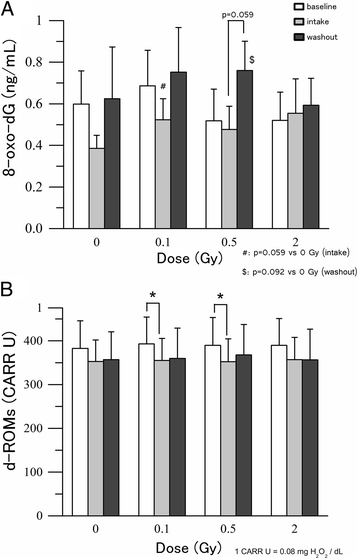Possible benefits of tomato juice consumption: a pilot study on irradiated human lymphocytes from healthy donors
- PMID: 28494764
- PMCID: PMC5427617
- DOI: 10.1186/s12937-017-0248-3
Possible benefits of tomato juice consumption: a pilot study on irradiated human lymphocytes from healthy donors
Abstract
Background: Reactive oxygen species (ROS) mediate much of the DNA damage caused by ionizing radiation. Among carotenoids, lycopene and β-carotene, present in tomato juice, are known to be strong radical scavengers. The aim of the study was to investigate the effect of tomato juice intake on the levels of DNA damage and oxidative stress in human whole blood induced by in vitro exposure to X-rays.
Methods: Ten healthy adults were asked to drink 190 g of tomato juice, containing 17 mg lycopene and 0.25 mg β-carotene, per day for 3 weeks and then refrain from drinking it for 3 weeks. Peripheral whole blood samples were collected before and after the intake period of tomato juice and after the washout period. The blood samples were exposed in vitro to X-ray doses of 0, 0.1, 0.5, and 2 Gy. Cytogenetic damage was measured using the cytokinesis-block micronucleus (CBMN) assay and the dicentrics (DIC) assay. The level of oxidative stress was determined using serum 8-oxo-7, 8-dihydro-2-deoxyguanosine (8-oxo-dG) and plasma reactive oxygen metabolite-derived compounds (d-ROMs). The concentration of carotenoids in plasma was measured at the three time points.
Results: The levels of 8-oxo-dG tended to decrease during the intake period and increase during the washout period. A non-significant inverse correlation was noted between the plasma concentration of lycopene plus β-carotene and the level of 8-oxo-dG (P = 0.064). The radiation-induced MN and DIC frequencies increased in a dose-dependent manner, and when compared at the same dose, the MN and DIC frequencies decreased during the intake period compared with those at baseline and then increased during the washout period. The results suggest that continuous tomato juice consumption non-significantly decreases extracellular 8-oxo-dG, d-ROMs, and MN. Tomato juice intake had minimal or no effect on radiation-induced 8-oxo-dG and d-ROMs. For most radiation doses, continuously tomato juice intake lowered the levels of MN and DIC.
Conclusion: Tomato juice consumption may suppress human lymphocyte DNA damage caused by radiation, but further examination is required.
Trial registration: 2014-001 and 2014-R06.
Keywords: Human lymphocytes; Lycopene; Radioprotective effect; Reactive oxygen species; Tomato juice; β-carotene.
Figures





Similar articles
-
Tomato juice intake suppressed serum concentration of 8-oxodG after extensive physical activity.Nutr J. 2012 May 2;11:29. doi: 10.1186/1475-2891-11-29. Nutr J. 2012. PMID: 22551119 Free PMC article. Clinical Trial.
-
Limited appearance of apocarotenoids is observed in plasma after consumption of tomato juices: a randomized human clinical trial.Am J Clin Nutr. 2018 Oct 1;108(4):784-792. doi: 10.1093/ajcn/nqy177. Am J Clin Nutr. 2018. PMID: 30239552 Free PMC article. Clinical Trial.
-
Oxidative DNA damage in prostate cancer patients consuming tomato sauce-based entrees as a whole-food intervention.J Natl Cancer Inst. 2001 Dec 19;93(24):1872-9. doi: 10.1093/jnci/93.24.1872. J Natl Cancer Inst. 2001. PMID: 11752012
-
Daily intake of a formulated tomato drink affects carotenoid plasma and lymphocyte concentrations and improves cellular antioxidant protection.Br J Nutr. 2005 Jan;93(1):93-9. doi: 10.1079/bjn20041315. Br J Nutr. 2005. PMID: 15705230 Review.
-
Tomato sauce supplementation and prostate cancer: lycopene accumulation and modulation of biomarkers of carcinogenesis.Exp Biol Med (Maywood). 2002 Nov;227(10):886-93. doi: 10.1177/153537020222701008. Exp Biol Med (Maywood). 2002. PMID: 12424330 Review.
Cited by
-
Metabolomics in Radiation Biodosimetry: Current Approaches and Advances.Metabolites. 2020 Aug 11;10(8):328. doi: 10.3390/metabo10080328. Metabolites. 2020. PMID: 32796693 Free PMC article. Review.
-
Tomato Juice Consumption Could Improve Breast Skin Adverse Effects of Radiotherapy in Breast Cancer Patients.In Vivo. 2020 Sep-Oct;34(5):3013-3021. doi: 10.21873/invivo.12133. In Vivo. 2020. PMID: 32871845 Free PMC article.
-
Lycopene and Vascular Health.Front Pharmacol. 2018 May 23;9:521. doi: 10.3389/fphar.2018.00521. eCollection 2018. Front Pharmacol. 2018. PMID: 29875663 Free PMC article. Review.
-
Effects of tomato ketchup and tomato paste extract on hepatic lipid accumulation and adipogenesis.Food Sci Biotechnol. 2023 Feb 6;32(8):1111-1122. doi: 10.1007/s10068-023-01244-x. eCollection 2023 Jul. Food Sci Biotechnol. 2023. PMID: 37215254 Free PMC article.
-
Effects of Tomato Juice Intake on Salivary 8-Oxo-dG Levels as Oxidative Stress Biomarker after Extensive Physical Exercise.Oxid Med Cell Longev. 2020 Jan 14;2020:8948723. doi: 10.1155/2020/8948723. eCollection 2020. Oxid Med Cell Longev. 2020. PMID: 32377311 Free PMC article.
References
MeSH terms
Substances
LinkOut - more resources
Full Text Sources
Other Literature Sources

